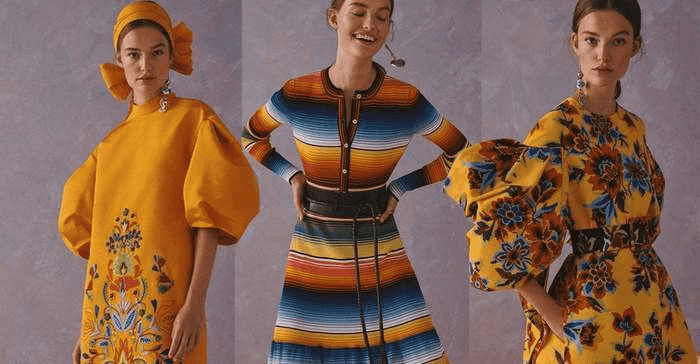Mexico vs. Carolina Herrera: designer accused of plagiarism by the Mexican government
The Ministry of Culture asks the designer of Carolina Herrera, Wes Gordon, an explanation for the use of designs and embroidery of native peoples.

The new Carolina Herrera 2020 cruise collection inspired by "a sunrise in Tulum, the light of Lima, a walk through the city of Mexico (...) or the colors of Cartagena" has generated discomfort in the Government of Mexico, which accuses its designer, Wes Gordon, of cultural appropriation. The secretary of Culture, Alejandra Frausto, requests in a letter addressed to Carolina Herrera and the creative director of the firm, Wes Gordon, "an explanation for the use of designs and embroideries of native peoples".
In that letter, Frausto vindicates "the cultural rights of the indigenous peoples" while requesting that "explain on what grounds they decided to make use of cultural elements whose origin is fully documented." "Carolina Herrera's new 2020 cruise collection is inspired by a colorful and colorful Latin vacation, the dawn of Tulum, the waves in José Ignacio, the dancing in Buenos Aires or the colors of Cartagena", explains the press release of the signature, belonging to the Puig group, with which you have contacted without receiving any reaction to this claim.
The designs do not seem to convince the government of Mexico, which considers that Carolina Herrera's garments contain the worldview of Mexican indigenous peoples, more so when it is working on a bill that protects its art and creativity to avoid plagiarism. One of the questioned models is a long white dress with bright embroidery of animals and flowers and Frausto points out in that letter that "this embroidery comes from the community of Tenango de Doria (Hidalgo), in these embroideries is the history of the community and each element has a personal, family and community meaning".
Others are dresses above the knee with colorful embroidered flowers like those made in the region of the isthmus of Tehuantepec, in Oaxaca. And a third case, in which Wes Gordon has designed some dresses with the typical sarape of Saltillo (Coahuila) that the Indians use to make warm clothes such as ponchos, jorongos, coats, or blankets. "It is a principle of ethical consideration that forces us to call attention and put on the table of sustainable development of the UN an urgent issue: promote inclusion and make visible the invisible," the letter ends.
After 37 years in the world of fashion and 72 fashion shows, Venezuelan Carolina Herrera bid farewell two years ago to the creative direction of the firm she created in 1981 and took the reins, Wes Gordon, in charge of creating this latest collection Crucero 2020 that has generated annoyances to the Mexican government.
But Carolina Herrera's is not the only case that the Mexican government has considered plagiarism. Zara, Mango, Isabel Marant, Louis Vuitton, and Michael Kors, Santa Marguerite, and Etoile have been some of the firms that have previously received a call from Mexico, which since last November is working on a law that safeguards indigenous culture. Until now, it seemed usual for designers to be inspired by different cultures to create their creative universe. It is enough to remember the Moschino, Gaultier, or Lacroix collections that they have created, for example, from the aesthetics of bullfighting. What once looked like inspiration today could be considered plagiarism.
Representatives of the museum expressed that the Resort 2020 collection recognizes the beauty of traditional Mexican design.
The Association of Friends of the Museum of Popular Art (AAMAP), a reference space in the preservation of traditional Mexican art, rejected through a statement the alleged plagiarism of Mexican designs made by the prestigious fashion house, Carolina Herrera; the previous thing after the accusations made by the Ministry of Culture. In the document addressed to the owner of the agency, Alejandra Frausto Guerrero, AAMAP said that the inspiration for the Resort 2020 collection "recognizes the beauty of traditional Mexican design giving it the importance it deserves on a global scale through the prestige of its brand".
They highlighted that in 2015 Carolina Herrera worked with AAMAP in the design of a bag embroidered by artisans from the municipality of Tenango de Doria in Hidalgo, who were justly paid for their work and given the corresponding credit. The organization made up of more than 50 businessmen, philanthropists, and artists mentioned that the firm collaborates closely with the work of the Museum of Popular Art and its projects with artisans.
The use of designs of indigenous communities on international catwalks is not new
Zara, Mango, Isabel Marant, and Rapsodia are other brands that have been designated to "appropriate" the designs of the indigenous peoples of Mexico.
"What they have to do is to come directly with us, firstly that the artisan is recognized so that other people know where it comes from, that they bring us to work," he says in his workshop, which is also his house, Oliver López, a young Otomi of 29 years, who like Carolina Herrera has also created minidresses with Tenango embroidery designs and other garments, but without the success of the New York fashion house.
Two other pieces from the Resort 2020 collection include embroideries from the Isthmus of Tehuantepec, which identify women from that region of southern Mexico, and two more models incorporate the "Sarape Saltillo", a kind of multicolored wool or cotton blanket, similar poncho, and used as a coat.




